Classifications of Sustainable Factors in Blockchain Adoption: A Literature Review and Bibliometric Analysis
Abstract
:1. Introduction
- The number of publications per year on Blockchain adoption.
- The publication map theme of Blockchain adoption.
- Countries most frequently associated with Blockchain adoption.
- Organizations most frequently associated with Blockchain adoption.
- Individual authors most frequently associated with Blockchain adoption.
- Articles most frequently cited in Blockchain adoption publications.
2. Background
2.1. Blockchain Technology
2.1.1. Characteristics of Blockchain
2.1.2. Blockchain Types
2.1.3. Blockchain Generations
2.2. Technology Adoption Theories
2.2.1. Diffusion of Innovation (DOI)
2.2.2. Technology Readiness and Acceptance Model (TRAM)
2.2.3. Technology Readiness Index (TRI)
2.2.4. Theory of Planned Behavior (TPB)
2.2.5. Task Technology Fit Model (TTF)
2.2.6. Technology Acceptance Model (TAM)
2.2.7. Unified Theory of Acceptance and Use of Technology (UTAUT)
2.2.8. Technology–Organization–Environment (TOE)
3. Materials and Methods
3.1. Generating Search Queries
- The number of publications per year on Blockchain adoption.
- The publication map theme of Blockchain adoption.
- Countries most frequently associated with Blockchain adoption.
- Organizations most frequently associated with Blockchain adoption.
- Individual authors most frequently associated with Blockchain adoption.
- Articles most frequently cited in Blockchain adoption publications.
- Summaries of related Blockchain adoption studies with relation to countries, industries, theories, methods, respondent sample sizes, and the number of factors included in each study.
- Identification of the top 18 most used adoption factors that appeared at least on 5 studies.
3.2. Literature Resources
3.3. Collection of Studies
- Identification 1: It was applied to Web of Science and returned 107 articles on 4 July 2021.
- Scientometric analysis: The Bibliometric analysis was then applied only to 107 Web of Science articles. Following the collection of the literature sample, a scientometric analysis was undertaken. Due to significant technological advancements, the scientometric analysis may now be conducted utilizing various existing applications. VOSviewer was used to create scientific mappings in this study because it possesses exceptional content mining skills and is well suited to deal with massive networks [57]. This study first analyzed the publication of Blockchain adoption based on 107 Web of Science articles to find the following information about Blockchain adoption publication using VOSviewer as VOSviewer can only work with one database:
- The number of publications per year on Blockchain adoption is based on the Web of Science database.
- The publication map theme of Blockchain adoption is based on the Web of Science database.
- Countries most frequently associated with Blockchain adoption are based on the Web of Science database.
- Organizations most frequently associated with Blockchain adoption are based on the Web of Science database.
- Individual authors most frequently associated with Blockchain adoption are based on the Web of Science database.
- Articles most frequently cited in Blockchain adoption publications are based on the Web of Science database.
- Identification 2: The research string was applied to Scopus and returned 120 articles. Articles from Scopus were added to enhance this study to find the following information:
- Summaries of related Blockchain adoption studies related to countries, industries, theories, methods, respondent sample sizes, and the number of factors included in each study based on Web of Science and Scopus databases.
- Identification of the top 18 most used adoption factors that appeared in at least 5 studies based on Web of Science database and Scopus database.
- Screening: Then, Scopus and Web of Science documents were combined into an Excel sheet. Ninety-two articles were excluded because they were duplicates, and seven articles were excluded because they could not be downloaded.
- Eligibility: Ninety-eight articles were excluded because they were not related to this study topic.
- Included: As a result, 30 articles were chosen at this stage. Full-text reading was conducted on the chosen 30 articles. Data relating to Blockchain adoption, such as the adoption model, the industry, the country, the method, and the sample size, were summarized. Additionally, the top 18 Blockchain adoption factors were summarized as they appeared in at least 5 articles.
3.4. Studies Selection (Eligibility and Inclusion)
- Was the study in English?
- Was the study published between 2015 and 2021?
- Was the study discussing Blockchain Technology adoption?
- Did the study include methodological evidence?
- Did the study propose an adoption model with adoption factors?
4. Results
4.1. The Number of Publications per Year on Blockchain Adoption
4.2. Map of Publication Themes of Blockchain adoption
4.3. Countries Most Frequently Affiliated with Blockchain Adoption
4.4. Organizations Most Frequently Affiliated with Blockchain Adoption
4.5. The Most Individual Authors of Blockchain Adoption Publication
4.6. The Most Cited Articles on Blockchain Adoption
4.7. Summary of Countries and Industries of Blockchain Adoption
4.8. Summary of Theories, Methods, Sample Size, and Factor Numbers of Blockchain Adoption
4.9. Summary of Top Blockchain Adoption Factors
5. Discussion
5.1. Relative Advantage
5.2. Security
5.3. Compatibility
5.4. Complexity
5.5. Organisational Readiness
5.6. Top Management Support
5.7. Perceived Usefulness
5.8. Perceived Ease of Use
5.9. Competitive Pressure
5.10. Performance Expectancy
5.11. Effort Expectancy
5.12. Social Influence
5.13. Facilitating Conditions
5.14. Attitude
5.15. Intention
5.16. Trust
5.17. Regulatory Support
5.18. Behavioural Expectation
6. Conceptual Framework
7. Conclusions
Author Contributions
Funding
Institutional Review Board Statement
Informed Consent Statement
Data Availability Statement
Acknowledgments
Conflicts of Interest
References
- Nakamoto, S.; Bitcoin, A. A Peer to Peer Electronic Cash System. 2009. Available online: https//bitcoin.org/bitcoin.pdf (accessed on 17 January 2022).
- Routray, J.K. Blockchain: How it is changing digital marketing? Splint Int. J. Prof. 2020, 7, 55–64. [Google Scholar]
- Casino, F.; Dasaklis, T.K.; Patsakis, C. A systematic literature review of blockchain-based applications: Current status, classification and open issues. Telemat. Inform. 2019, 36, 55–81. [Google Scholar] [CrossRef]
- Gandal, N.; Hamrick, J.T.; Moore, T.; Oberman, T. Price manipulation in the Bitcoin ecosystem. J. Monet. Econ. 2018, 95, 86–96. [Google Scholar] [CrossRef]
- Tschorsch, F.; Scheuermann, B. Bitcoin and beyond: A technical survey on decentralized digital currencies. IEEE Commun. Surv. Tutor. 2016, 18, 2084–2123. [Google Scholar] [CrossRef]
- Sarra, C. Lost in Translation: Dogmatic, Methodological and Philosophical Issues of Contractual Automation. In A Contemporary Anthology of Law; Atiner: Athens, Greece, 2022. [Google Scholar]
- Zhao, J.L.; Fan, S.; Yan, J. Overview of business innovations and research opportunities in blockchain and introduction to the special issue. Financ. Innov. 2016, 2, 28. [Google Scholar] [CrossRef] [Green Version]
- Nandakumar, K.; Ratha, N.; Pankanti, S.; Pentland, A.; Herlihy, M. Blockchain: From Technology to Marketplaces. Computer 2020, 53, 14–18. [Google Scholar] [CrossRef]
- Christidis, K.; Devetsikiotis, M. Blockchains and smart contracts for the internet of things. IEEE Access 2016, 4, 2292–2303. [Google Scholar] [CrossRef]
- Tarhini, A.; El-Masri, M.; Ali, M.; Serrano, A. Extending the UTAUT model to understand the customers’ acceptance and use of internet banking in Lebanon: A structural equation modeling approach. Inf. Technol. People 2016, 29, 830–849. [Google Scholar] [CrossRef] [Green Version]
- Bayram, E.; Dougan, B.; Tunali, V. Bibliometric Analysis of the Tertiary Study on Agile Software Development using Social Network Analysis. In Proceedings of the 2020 Innovations in Intelligent Systems and Applications Conference (ASYU), Istanbul, Turkey, 15–17 October 2020; pp. 1–4. [Google Scholar]
- Bayram, E.; Dougan, B.; Tunali, V. A Tertiary Study and Social Network Analysis on Agile Software Development Methodology. Int. J. Adv. Eng. Pure Sci. 2022, 33, 35–46. [Google Scholar] [CrossRef]
- Ammar, A.-A.; Dominic, P.D.D.; Basri, S.; Al-Tashi, Q.; Muneer, A.; Ghaleb, E.A.A. Software Process Improvement During the Last Decade: A Theoretical Mapping and Future Avenues. In Proceedings of the 2021 International Congress of Advanced Technology and Engineering (ICOTEN), Online, 4–5 July 2021; pp. 1–5. [Google Scholar]
- Nazim, N.F.; Razis, N.M.; Hatta, M.F.M. Behavioural intention to adopt blockchain technology among bankers in islamic financial system: Perspectives in Malaysia. Rom. J. Inf. Technol. Autom. Control 2021, 31, 11–28. [Google Scholar] [CrossRef]
- Bigi, M.; Greenan, N.; Hamon-Cholet, S.; Lanfranchi, J. The human sustainability of ICT and management changes: Evidence for the French public and private sectors. Sustainability 2018, 10, 3570. [Google Scholar] [CrossRef] [Green Version]
- Ahmed, F.; Qin, Y.J.; Martinez, L. Sustainable change management through employee readiness: Decision support system adoption in technology-intensive British e-businesses. Sustainability 2019, 11, 2998. [Google Scholar] [CrossRef] [Green Version]
- Ur Rahman, R.; Ali Shah, S.M.; El-Gohary, H.; Abbas, M.; Haider Khalil, S.; Al Altheeb, S.; Sultan, F. Social media adoption and financial sustainability: Learned lessons from developing countries. Sustainability 2020, 12, 10616. [Google Scholar] [CrossRef]
- Tenakwah, E.; Tenakwah, E.J.; Amponsah, M.; Eyaa, S.; Boateng, E.; Okhawere, N. Adoption of Sustainable Technologies During Crisis: Examining employees’ perception and readiness across cultures. Sustainability 2022, 14, 4605. [Google Scholar] [CrossRef]
- Paradza, D.; Daramola, O. Business Intelligence and Business Value in Organisations: A Systematic Literature Review. Sustainability 2021, 13, 11382. [Google Scholar] [CrossRef]
- Chauhan, V.; Yadav, R.; Choudhary, V. Analyzing the impact of consumer innovativeness and perceived risk in internet banking adoption: A study of Indian consumers. Int. J. Bank Mark. 2019, 37, 323–339. [Google Scholar] [CrossRef]
- Crosby, M.; Pattanayak, P.; Verma, S.; Kalyanaraman, V. Blockchain technology: Beyond bitcoin. Appl. Innov. 2016, 2, 71. [Google Scholar]
- Neisse, R.; Steri, G.; Nai-Fovino, I. A blockchain-based approach for data accountability and provenance tracking. In Proceedings of the 12th International Conference on Availability, Reliability and Security, Reggio Calabria, Italy, 29 August–1 September 2017; pp. 1–10. [Google Scholar]
- White, G.R.T. Future applications of blockchain in business and management: A Delphi study. Strateg. Chang. 2017, 26, 439–451. [Google Scholar] [CrossRef]
- Hölbl, M.; Kompara, M.; Kamišalić, A.; Nemec Zlatolas, L. A systematic review of the use of blockchain in healthcare. Symmetry 2018, 10, 470. [Google Scholar] [CrossRef] [Green Version]
- Akbar, N.A.; Muneer, A.; ElHakim, N.; Fati, S.M. Distributed Hybrid Double-Spending Attack Prevention Mechanism for Proof-of-Work and Proof-of-Stake Blockchain Consensuses. Future Internet 2021, 13, 285. [Google Scholar] [CrossRef]
- Vafiadis, N.V.; Taefi, T.T. Differentiating blockchain technology to optimize the processes quality in industry 4.0. In Proceedings of the 2019 IEEE 5th World Forum on Internet of Things (WF-IoT), Limerick, Ireland, 15–18 April 2019; pp. 864–869. [Google Scholar]
- Zheng, Z.; Xie, S.; Dai, H.-N.; Chen, X.; Wang, H. Blockchain challenges and opportunities: A survey. Int. J. Web Grid Serv. 2018, 14, 352–375. [Google Scholar] [CrossRef]
- Hewa, T.; Ylianttila, M.; Liyanage, M. Survey on blockchain based smart contracts: Applications, opportunities and challenges. J. Netw. Comput. Appl. 2021, 177, 102857. [Google Scholar] [CrossRef]
- AL-Ashmori, A.; Basri, S.; Dominic, P.D.D.; Muneer, A.; Al-Tashi, Q.; Al-Ashmori, Y. Blockchain-Oriented Software Development Issues: A Literature Review. Proc. Comput. Methods Syst. Softw. 2021, 232, 48–57. [Google Scholar]
- Almekhlafi, S.; Al-Shaibany, N. The literature review of blockchain adoption. Asian J. Res. Comput. Sci. 2021, 7, 29–50. [Google Scholar] [CrossRef]
- Clohessy, T.; Acton, T. Investigating the influence of organizational factors on blockchain adoption: An innovation theory perspective. Ind. Manag. Data Syst. 2019, 119, 35. [Google Scholar] [CrossRef]
- Colomo-Palacios, R.; Sánchez-Gordón, M.; Arias-Aranda, D. A critical review on blockchain assessment initiatives: A technology evolution viewpoint. J. Softw. Evol. Process 2020, 32, e2272. [Google Scholar] [CrossRef]
- Mohammed, A.; Potdar, V.; Yang, L. Key factors affecting blockchain adoption in organizations. In Proceedings of the International Conference on Big Data and Security, Nanjing, China, 20–22 December 2019; pp. 455–467. [Google Scholar]
- Ali, R.F.; Muneer, A.; Dominic, P.D.D.; Taib, S.M. Hyperledger Fabric Framework with 5G Network for Blockchain-based Security of IoT Smart Home Applications. In Proceedings of the 2021 International Conference on Decision Aid Sciences and Application (DASA), Online, 7–8 December 2021; pp. 1109–1114. [Google Scholar]
- Lai, P.C. Design and Security impact on consumers’ intention to use single platform E-payment. Interdiscip. Inf. Sci. 2016, 22, 111–122. [Google Scholar] [CrossRef] [Green Version]
- Everett, M. (Ed.) Diffusion of Innovations, 4th ed.; Free Press: New York, NY, USA, 1995. [Google Scholar]
- Charles, L.; Colby, A. (Eds.) Techno-Ready Marketing: How and Why Customers Adopt Technology; Free Press: New York, NY, USA, 2001. [Google Scholar]
- Ajzen, I. The theory of planned behavior. Organ. Behav. Hum. Decis. Process. 1991, 50, 179–211. [Google Scholar] [CrossRef]
- Fishbein, M.; Ajzen, I. Belief, attitude, intention, and behavior: An introduction to theory and research. Philos. Rhetor. 1977, 10, 244–245. [Google Scholar]
- Shih, Y.-Y.; Fang, K. The use of a decomposed theory of planned behavior to study Internet banking in Taiwan. Internet Res. 2004, 14, 213–223. [Google Scholar] [CrossRef] [Green Version]
- Goodhue, D.L.; Thompson, R.L. Task-technology fit and individual performance. MIS Q. 1995, 19, 213–236. [Google Scholar] [CrossRef]
- Albaom, M.A.; Sidi1, F.; Jabar, M.A.; Abdullah, R.; Ishak, I.; Yunikawati, N.A.; Priambodo, M.P.; Husen, J.H.; Issac, O.; Al-Harasi, A.H.; et al. The Impact of Tourist’s Intention to Use Web 3.0: A Conceptual Integrate, d Model Based on Tam & Dmism Faculty of Business and Management, Universiti Teknologi MARA (UITM) Malaysia. J. Theor. Appl. Inf. Technol. 2021, 31, 24. [Google Scholar]
- Alzubi, M.M.; Al-Dubai, M.M.; Farea, M.M. Using the technology acceptance model in understanding citizens’ behavioural intention to use m-marketing among Jordanian citizen. J. Bus. Retail Manag. Res. 2018, 12, 12. [Google Scholar] [CrossRef] [Green Version]
- Samaradiwakara, G.; Gunawardena, C.G. Comparison of existing technology acceptance theories and models to suggest a well improved theory/model. Int. Tech. Sci. J. 2014, 1, 21–36. [Google Scholar]
- Venkatesh, V. Determinants of perceived ease of use: Integrating control, intrinsic motivation, and emotion into the technology acceptance model. Inf. Syst. Res. 2000, 11, 342–365. [Google Scholar] [CrossRef] [Green Version]
- Pan, Y.; Froese, F.; Liu, N.; Hu, Y.; Ye, M. The adoption of artificial intelligence in employee recruitment: The influence of contextual factors. Int. J. Hum. Resour. Manag. 2022, 33, 1125–1147. [Google Scholar] [CrossRef]
- Wisdom, J.P.; Chor, K.H.B.; Hoagwood, K.E.; Horwitz, S.M. Innovation adoption: A review of theories and constructs. Adm. Policy Ment. Heal. Ment. Heal. Serv. Res. 2014, 41, 480–502. [Google Scholar] [CrossRef] [PubMed]
- Tornatzky, L.G.; Fleischer, M.; Chakrabarti, A.K. Processes of Technological Innovation; Lexington Books: Lanham, MD, USA, 1990. [Google Scholar]
- Dedrick, J.; West, J. Why firms adopt open source platforms: A grounded theory of innovation and standards adoption. In Proceedings of the Workshop on Standard Making: A critical Research Frontier for Information Systems, Seattle, WA, USA, 12–14 December 2003; pp. 236–257. Available online: https://www.researchgate.net/profile/Joel-West-2/publication/239184573_Why_firms_adopt_open_source_platforms_A_grounded_theory_of_innovation_and_standards_adoption/links/55d1f0a008ae3dc86a4f354e/Why-firms-adopt-open-source-platforms-A-grounded-theory-of-innovation-and-standards-adoption.pdfc (accessed on 17 January 2022).
- Liberati, A.; Altman, D.G.; Tetzlaff, J.; Mulrow, C.; Gøtzsche, P.C.; Ioannidis, J.P.A.; Clarke, M.; Devereaux, P.J.; Kleijnen, J.; Moher, D. The PRISMA statement for reporting systematic reviews and meta-analyses of studies that evaluate health care interventions: Explanation and elaboration. J. Clin. Epidemiol. 2009, 62, e1–e34. [Google Scholar] [CrossRef] [Green Version]
- Ali, R.F.; Dominic, P.D.D.; Ali, S.E.A.; Rehman, M.; Sohail, A. Information security behavior and information security policy compliance: A systematic literature review for identifying the transformation process from noncompliance to compliance. Appl. Sci. 2021, 11, 3383. [Google Scholar] [CrossRef]
- Pranckute, R. Web of Science (WoS) and Scopus: The titans of bibliographic information in today’s academic world. Publications 2021, 9, 12. [Google Scholar] [CrossRef]
- Zhu, J.; Liu, W. A tale of two databases: The use of Web of Science and Scopus in academic papers. Scientometrics 2020, 123, 321–335. [Google Scholar] [CrossRef] [Green Version]
- Li, K.; Rollins, J.; Yan, E. Web of Science use in published research and review papers 1997–2017: A selective, dynamic, cross-domain, content-based analysis. Scientometrics 2018, 115, 1–20. [Google Scholar] [CrossRef] [Green Version]
- Baas, J.; Schotten, M.; Plume, A.; Côté, G.; Karimi, R. Scopus as a curated, high-quality bibliometric data source for academic research in quantitative science studies. Quant. Sci. Stud. 2020, 1, 377–386. [Google Scholar] [CrossRef]
- Aghaei Chadegani, A.; Salehi, H.; Yunus, M.; Farhadi, H.; Fooladi, M.; Farhadi, M.; Ale Ebrahim, N. A comparison between two main academic literature collections: Web of Science and Scopus databases. Asian Soc. Sci. 2013, 9, 18–26. [Google Scholar] [CrossRef] [Green Version]
- Van Eck, N.; Waltman, L. Software survey: VOSviewer, a computer program for bibliometric mapping. Scientometrics 2010, 84, 523–538. [Google Scholar] [CrossRef] [Green Version]
- Francisco, K.; Swanson, D. The supply chain has no clothes: Technology adoption of blockchain for supply chain transparency. Logistics 2018, 2, 2. [Google Scholar] [CrossRef] [Green Version]
- Queiroz, M.M.; Wamba, S.F. Blockchain adoption challenges in supply chain: An empirical investigation of the main drivers in India and the USA. Int. J. Inf. Manag. 2019, 46, 70–82. [Google Scholar] [CrossRef]
- Wang, Y.; Han, J.H.; Beynon-Davies, P. Understanding blockchain technology for future supply chains: A systematic literature review and research agenda. Supply Chain Manag. Int. J. 2018, 24, 62–84. [Google Scholar] [CrossRef]
- Li, X.; Wang, C.A. The technology and economic determinants of cryptocurrency exchange rates: The case of Bitcoin. Decis. Support Syst. 2017, 95, 49–60. [Google Scholar] [CrossRef]
- Kamble, S.; Gunasekaran, A.; Arha, H. Understanding the Blockchain technology adoption in supply chains-Indian context. Int. J. Prod. Res. 2019, 57, 2009–2033. [Google Scholar] [CrossRef]
- Queiroz, M.M.; Telles, R.; Bonilla, S.H. Blockchain and supply chain management integration: A systematic review of the literature. Supply Chain Manag. Int. J. 2019, 25, 241–254. [Google Scholar] [CrossRef]
- Dobrovnik, M.; Herold, D.M.; Fürst, E.; Kummer, S. Blockchain for and in Logistics: What to Adopt and Where to Start. Logistics 2018, 2, 18. [Google Scholar] [CrossRef] [Green Version]
- Wong, L.-W.; Leong, L.-Y.; Hew, J.-J.; Tan, G.W.-H.; Ooi, K.-B. Time to seize the digital evolution: Adoption of blockchain in operations and supply chain management among Malaysian SMEs. Int. J. Inf. Manag. 2020, 52, 101997. [Google Scholar] [CrossRef]
- Alladi, T.; Chamola, V.; Parizi, R.M.; Choo, K.-K.R. Blockchain applications for industry 4.0 and industrial IoT: A review. IEEE Access 2019, 7, 176935–176951. [Google Scholar] [CrossRef]
- Angelis, J.; Da Silva, E.R. Blockchain adoption: A value driver perspective. Bus. Horiz. 2019, 62, 307–314. [Google Scholar] [CrossRef]
- Schuetz, S.; Venkatesh, V. Blockchain, adoption, and financial inclusion in India: Research opportunities. Int. J. Inf. Manag. 2020, 52, 101936. [Google Scholar] [CrossRef]
- Kamble, S.S.; Gunasekaran, A.; Kumar, V.; Belhadi, A.; Foropon, C. A machine learning based approach for predicting blockchain adoption in supply Chain. Technol. Forecast. Soc. Chang. 2021, 163, 120465. [Google Scholar] [CrossRef]
- Park, K.O. A study on sustainable usage intention of blockchain in the big data era: Logistics and supply chain management companies. Sustainability 2020, 12, 10670. [Google Scholar] [CrossRef]
- Albayati, H.; Kim, S.K.; Rho, J.J. Accepting financial transactions using blockchain technology and cryptocurrency: A customer perspective approach. Technol. Soc. 2020, 62, 101320. [Google Scholar] [CrossRef]
- Palos-Sanchez, P.; Saura, J.R.; Ayestaran, R. An exploratory approach to the adoption process of bitcoin by business executives. Mathematics 2021, 9, 355. [Google Scholar] [CrossRef]
- Ferri, L.; Spanò, R.; Ginesti, G.; Theodosopoulos, G. Ascertaining auditors’ intentions to use blockchain technology: Evidence from the Big 4 accountancy firms in Italy. Meditari Account. Res. 2020, 29, 1063–1087. [Google Scholar] [CrossRef]
- Shrestha, A.K.; Vassileva, J.; Joshi, S.; Just, J. Augmenting the technology acceptance model with trust model for the initial adoption of a blockchain-based system. PeerJ Comput. Sci. 2021, 7, e502. [Google Scholar] [CrossRef] [PubMed]
- Kabir, M.R. Behavioural intention to adopt blockchain for a transparent and effective taxing system. J. Glob. Oper. Strateg. Sourc. 2020, 14, 170–201. [Google Scholar] [CrossRef]
- Kulkarni, M.; Patil, K. Block chain technology adoption using toe framework. Int. J. Sci. Technol. Res. 2020, 9, 1109–1117. [Google Scholar]
- Queiroz, M.M.; Fosso Wamba, S.; De Bourmont, M.; Telles, R. Blockchain adoption in operations and supply chain management: Empirical evidence from an emerging economy. Int. J. Prod. Res. 2021, 59, 6087–6103. [Google Scholar] [CrossRef]
- Jain, G.; Singh, H.; Chaturvedi, K.R.; Rakesh, S. Blockchain in logistics industry: In fizz customer trust or not. J. Enterp. Inf. Manag. 2020, 33, 541–558. [Google Scholar] [CrossRef]
- Nuryyev, G.; Wang, Y.-P.; Achyldurdyyeva, J.; Jaw, B.-S.; Yeh, Y.-S.; Lin, H.-T.; Wu, L.-F. Blockchain technology adoption behavior and sustainability of the business in tourism and hospitality SMEs: An empirical study. Sustainability 2020, 12, 1256. [Google Scholar] [CrossRef]
- Ullah, N.; Mugahed Al-Rahmi, W.; Alzahrani, A.I.; Alfarraj, O.; Alblehai, F.M. Blockchain technology adoption in smart learning environments. Sustainability 2021, 13, 1801. [Google Scholar] [CrossRef]
- Alazab, M.; Alhyari, S.; Awajan, A.; Abdallah, A.B. Blockchain technology in supply chain management: An empirical study of the factors affecting user adoption/acceptance. Clust. Comput. 2021, 24, 83–101. [Google Scholar] [CrossRef]
- Gökalp, E.; Gökalp, M.O.; Çoban, S. Blockchain-based supply chain management: Understanding the determinants of adoption in the context of organizations. Inf. Syst. Manag. 2022, 39, 100–121. [Google Scholar] [CrossRef]
- Tran, L.T.T.; Nguyen, P.T.; Trong, L.; Tran, T.; Nguyen, P.T. Co-creating blockchain adoption: Theory, practice and impact on usage behavior. Asia Pac. J. Mark. Logist. 2020, 33, 1667–1684. [Google Scholar] [CrossRef]
- Lin, X.; Chang, S.-C.; Chou, T.-H.; Chen, S.-C.; Ruangkanjanases, A. Consumers’ intention to adopt blockchain food traceability technology towards organic food products. Int. J. Environ. Res. Public Health 2021, 18, 912. [Google Scholar] [CrossRef] [PubMed]
- Orji, I.J.; Kusi-Sarpong, S.; Huang, S.; Vazquez-Brust, D. Evaluating the factors that influence blockchain adoption in the freight logistics industry. Transp. Res. Part E Logist. Transp. Rev. 2020, 141, 102025. [Google Scholar] [CrossRef]
- Muhamad, W.N.W.; Razali, N.A.M.; Wook, M.; Ishak, K.K.; Zainudin, N.M.; Hasbullah, N.A.; Ramli, S. Evaluation of Blockchain-based Data Sharing Acceptance Among Intelligence Community. Evaluation 2020, 11, 159–174. [Google Scholar] [CrossRef]
- Khazaei, H. Integrating cognitive antecedents to UTAUT model to explain adoption of blockchain technology among Malaysian SMEs. JOIV Int. J. Inform. Vis. 2020, 4, 85–90. [Google Scholar] [CrossRef]
- Ullah, N.; Alnumay, W.S.; Al-Rahmi, W.M.; Alzahrani, A.I.; Al-Samarraie, H. Modeling cost saving and innovativeness for blockchain technology adoption by energy management. Energies 2020, 13, 4783. [Google Scholar] [CrossRef]
- Chillakuri, B.; Attili, V.S.P. Role of blockchain in HR’s response to new-normal. Int. J. Organ. Anal. 2021. ahead-of-print. [Google Scholar] [CrossRef]
- Razali, N.A.M.; Wan Muhamad, W.N.; Ishak, K.K.; Saad, N.J.A.M.; Wook, M.; Ramli, S. Secure Blockchain-Based Data-Sharing Model and Adoption among Intelligence Communities. IAENG Int. J. Comput. Sci. 2021, 48, 18–31. [Google Scholar]
- Badi, S.; Ochieng, E.; Nasaj, M.; Papadaki, M. Technological, organisational and environmental determinants of smart contracts adoption: UK construction sector viewpoint. Constr. Manag. Econ. 2021, 39, 36–54. [Google Scholar] [CrossRef]
- Fernando, Y.; Rozuar, N.H.M.; Mergeresa, F. The blockchain-enabled technology and carbon performance: Insights from early adopters. Technol. Soc. 2021, 64, 101507. [Google Scholar] [CrossRef]
- Wong, L.-W.; Tan, G.W.-H.; Lee, V.-H.; Ooi, K.-B.; Sohal, A. Unearthing the determinants of Blockchain adoption in supply chain management. Int. J. Prod. Res. 2020, 58, 2100–2123. [Google Scholar] [CrossRef] [Green Version]
- Blockchain Issues Need to Be Understood and Addressed|Business Weekly|Technology News|Business News|Cambridge and the East of England. Available online: https://www.businessweekly.co.uk/blog/business-weekly-guest-blog/blockchain-issues-need-be-understood-and-addressed (accessed on 17 January 2022).
- Gangwar, H.; Date, H.; Ramaswamy, R. Understanding determinants of cloud computing adoption using an integrated TAM-TOE model. J. Enterp. Inf. Manag. 2015, 28, 107–130. [Google Scholar] [CrossRef]
- Hua, Y.; Jiang, H.; Zhu, Y.; Feng, D.; Tian, L. SmartStore: A new metadata organization paradigm with semantic-awareness for next-generation file systems. In Proceedings of the Conference on High Performance Computing Networking, Storage and Analysis, Portland, OR, USA, 14–20 November 2009; pp. 1–12. [Google Scholar]
- Huckle, S.; Bhattacharya, R.; White, M.; Beloff, N. Internet of things, blockchain and shared economy applications. Procedia Comput. Sci. 2016, 98, 461–466. [Google Scholar] [CrossRef] [Green Version]
- Ouaddah, A.; Elkalam, A.A.; Ouahman, A.A. Towards a novel privacy-preserving access control model based on blockchain technology in IoT. In Europe and MENA Cooperation Advances in Information and Communication Technologies; Springer: Berlin/Heidelberg, Germany, 2017; pp. 523–533. [Google Scholar]
- Belkhamza, Z.; Wafa, S.A. The effect of perceived risk on the intention to use e-commerce: The case of Algeria. J. Internet Bank. Commer. 1970, 14, 1–10. [Google Scholar]
- Pazaitis, A.; De Filippi, P.; Kostakis, V. Blockchain and value systems in the sharing economy: The illustrative case of Backfeed. Technol. Forecast. Soc. Chang. 2017, 125, 105–115. [Google Scholar] [CrossRef]
- Mthethwa, S. The analysis of the blockchain technology and challenges. World Acad. Sci. Eng. Technol. Int. Sci. Index Comput. Inf. Eng. 2016, 10, 1937–1948. [Google Scholar]
- Sonnenwald, D.H.; Maglaughlin, K.L.; Whitton, M.C. Using innovation diffusion theory to guide collaboration technology evaluation: Work in progress. In Proceedings of the 10th IEEE International Workshop on Enabling Technologies: Infrastructure for Collaborative Enterprises, Washington, DC, USA, 20–22 June 2001; pp. 114–119. [Google Scholar]
- Eyal, I.; Gencer, A.E.; Sirer, E.G.; Van Renesse, R. Bitcoin-NG: A Scalable Blockchain Protocol. In Proceedings of the 13th USENIX Symposium on Networked Systems Design and Implementation (NSDI 16), Santa Clara, CA, USA, 2 February 2016; pp. 45–59. [Google Scholar]
- Khan, M.A.; Salah, K. IoT security: Review, blockchain solutions, and open challenges. Future Gener. Comput. Syst. 2018, 82, 395–411. [Google Scholar] [CrossRef]
- Bentov, I.; Gabizon, A.; Mizrahi, A. Cryptocurrencies without proof of work. In Proceedings of the International Conference on Financial Cryptography and Data Security, Christ Church, Barbados, 22–26 February 2016; pp. 142–157. [Google Scholar]
- Musawa, M.S.; Wahab, E. The adoption of electronic data interchange (EDI) technology by Nigerian SMEs: A conceptual framework. J. Bus. Manag. Econ. 2012, 3, 55–68. [Google Scholar]
- Raghunathan, B.; Raghunathan, T.S. Impact of top management support on IS planning. J. Inf. Syst. 1988, 2, 15–23. [Google Scholar]
- Ghaleb, E.A.A.; Dominic, P.D.D.; Fati, S.M.; Muneer, A.; Ali, R.F. The Assessment of Big Data Adoption Readiness with a Technology–Organization–Environment Framework: A Perspective towards Healthcare Employees. Sustainability 2021, 13, 8379. [Google Scholar] [CrossRef]
- Davis, F.D. Perceived Usefulness, Perceived Ease of Use, and User Acceptance of Information Technology. MIS Q. 1989, 13, 319–340. [Google Scholar] [CrossRef] [Green Version]
- Zhu, K.; Kraemer, K.L. Post-adoption variations in usage and value of e-business by organizations: Cross-country evidence from the retail industry. Inf. Syst. Res. 2005, 16, 61–84. [Google Scholar] [CrossRef] [Green Version]
- Porter, M.E.; Millar, V.E. How Information Gives You Competitive Advantage 1985. Available online: http://faculty.yu.edu.jo/iaad/Lists/Taught%20Courses/Attachments/5/Reading%205-How%20Information%20Gives%20You%20Comp-Fall2015.pdf (accessed on 17 January 2022).
- Venkatesh, V.; Thong, J.Y.L.; Xu, X. Consumer Acceptance and Use of Information Technology: Extending the Unified Theory of Acceptance and Use of Technology. MIS Q. 2012, 36, 157–178. [Google Scholar] [CrossRef] [Green Version]
- Schmitz, J.; Leoni, G. Accounting and auditing at the time of blockchain technology: A research agenda. Aust. Account. Rev. 2019, 29, 331–342. [Google Scholar] [CrossRef]
- Martins, C.; Oliveira, T.; Popovič, A. Understanding the Internet banking adoption: A unified theory of acceptance and use of technology and perceived risk application. Int. J. Inf. Manag. 2014, 34, 1–13. [Google Scholar] [CrossRef]
- Chaouali, W.; Yahia, I.B.; Souiden, N. The interplay of counter-conformity motivation, social influence, and trust in customers’ intention to adopt Internet banking services: The case of an emerging country. J. Retail. Consum. Serv. 2016, 28, 209–218. [Google Scholar] [CrossRef]
- Davis, F.D. A Technology Acceptance Model for Empirically Testing New End-User Information Systems: Theory and Results; Massachusetts Institute of Technology: Cambridge, MA, USA, 1985. [Google Scholar]
- Sheppard, B.H.; Hartwick, J.; Warshaw, P.R. The theory of reasoned action: A meta-analysis of past research with recommendations for modifications and future research. J. Consum. Res. 1988, 15, 325–343. [Google Scholar] [CrossRef]
- McCloskey, D.W. The Importance of Ease of Use, Usefulness, and Trust to Online Consumers: An Examination of the Technology Acceptance Model with Older Customers. In End-User Computing: Concepts, Methodologies, Tools, and Applications; IGI Global: Hershey, PA, USA, 2008; pp. 1620–1636. [Google Scholar]
- Mayer, R.C.; Davis, J.H.; Schoorman, F.D. An integrative model of organizational trust. Acad. Manag. Rev. 1995, 20, 709–734. [Google Scholar] [CrossRef]
- Peters, G.; Panayi, E.; Chapelle, A. Trends in cryptocurrencies and blockchain technologies: A monetary theory and regulation perspective. J. Financ. Perspect. 2015, 3, 30–31. [Google Scholar]
- Lu, Y. Blockchain: A survey on functions, applications and open issues. J. Ind. Integr. Manag. 2018, 3, 1850015. [Google Scholar] [CrossRef]
- Maruping, L.M.; Bala, H.; Venkatesh, V.; Brown, S.A. Going beyond intention: Integrating behavioral expectation into the unified theory of acceptance and use of technology. J. Assoc. Inf. Sci. Technol. 2017, 68, 623–637. [Google Scholar] [CrossRef]
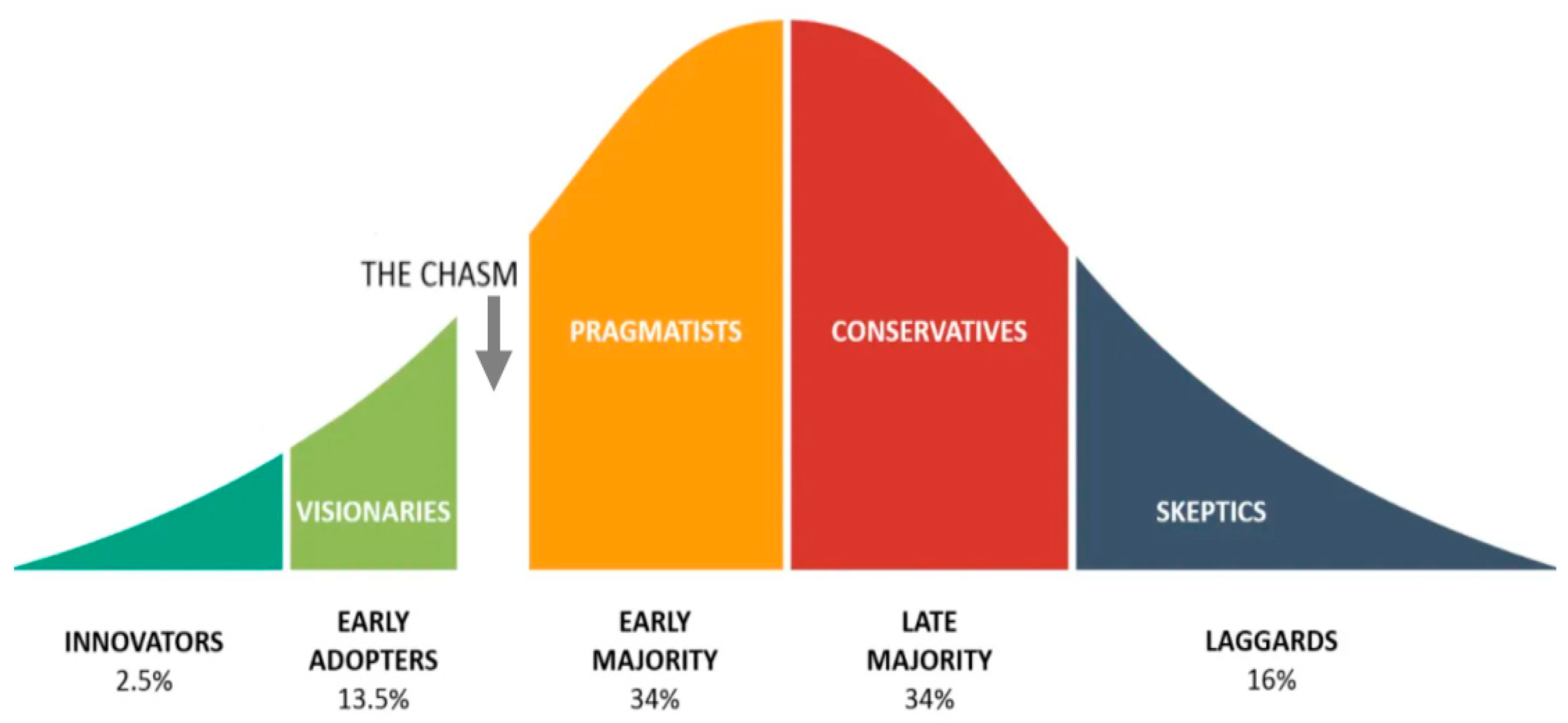
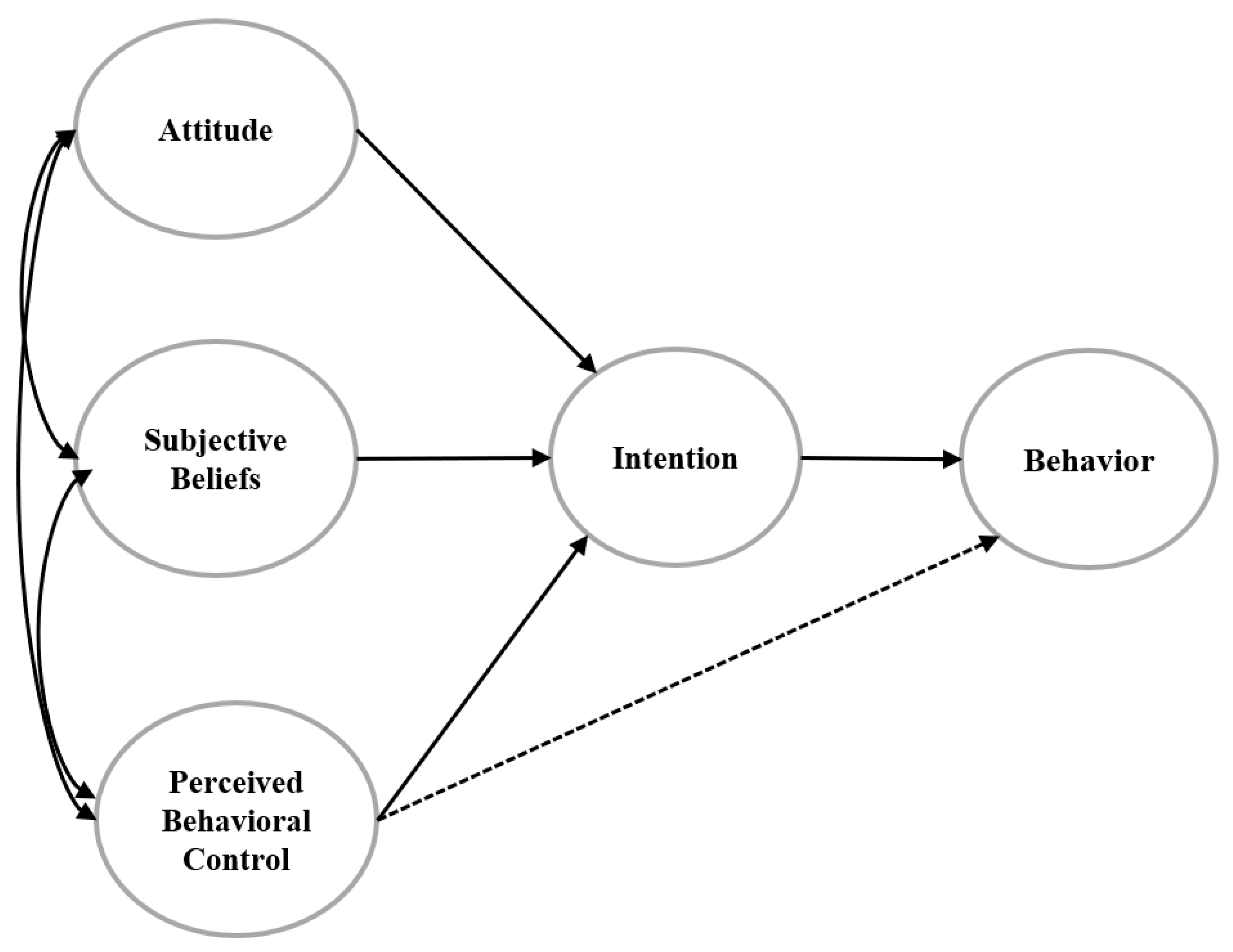

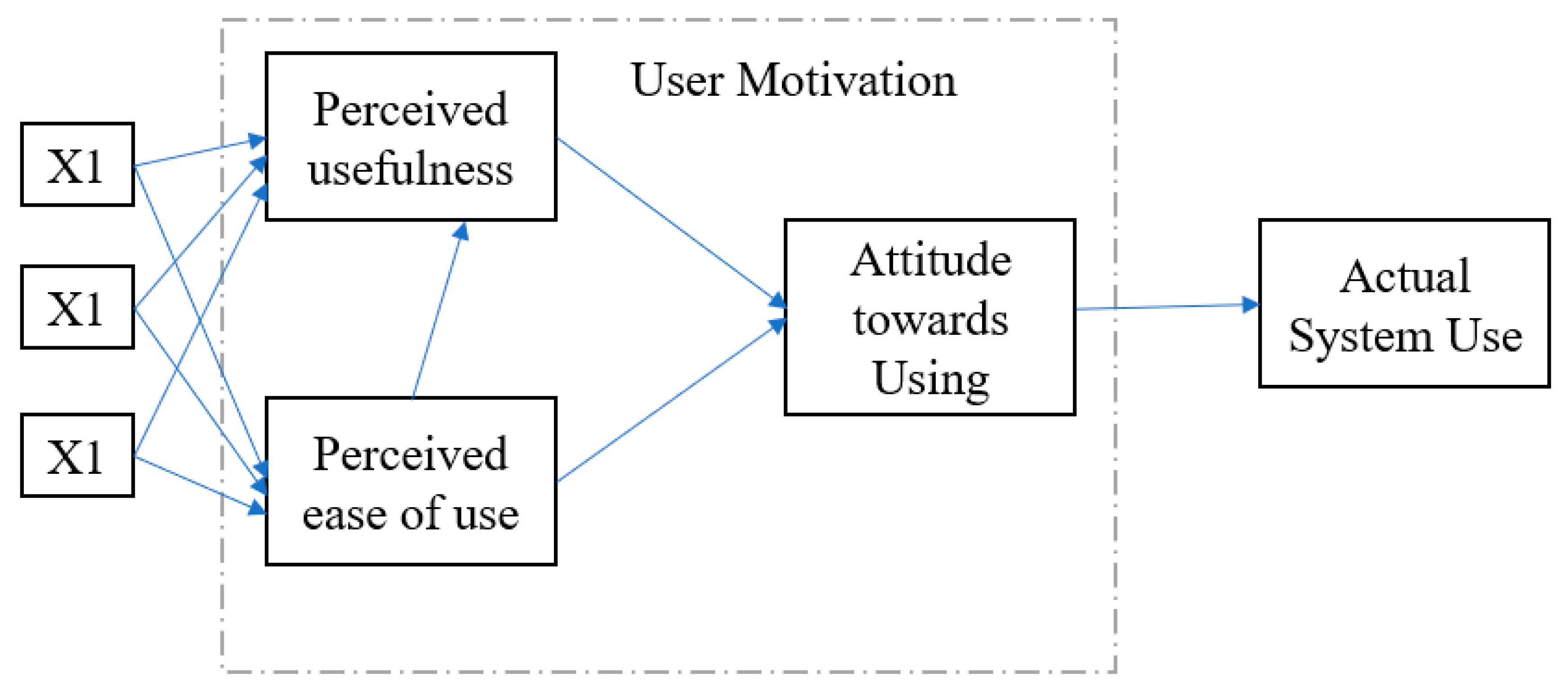
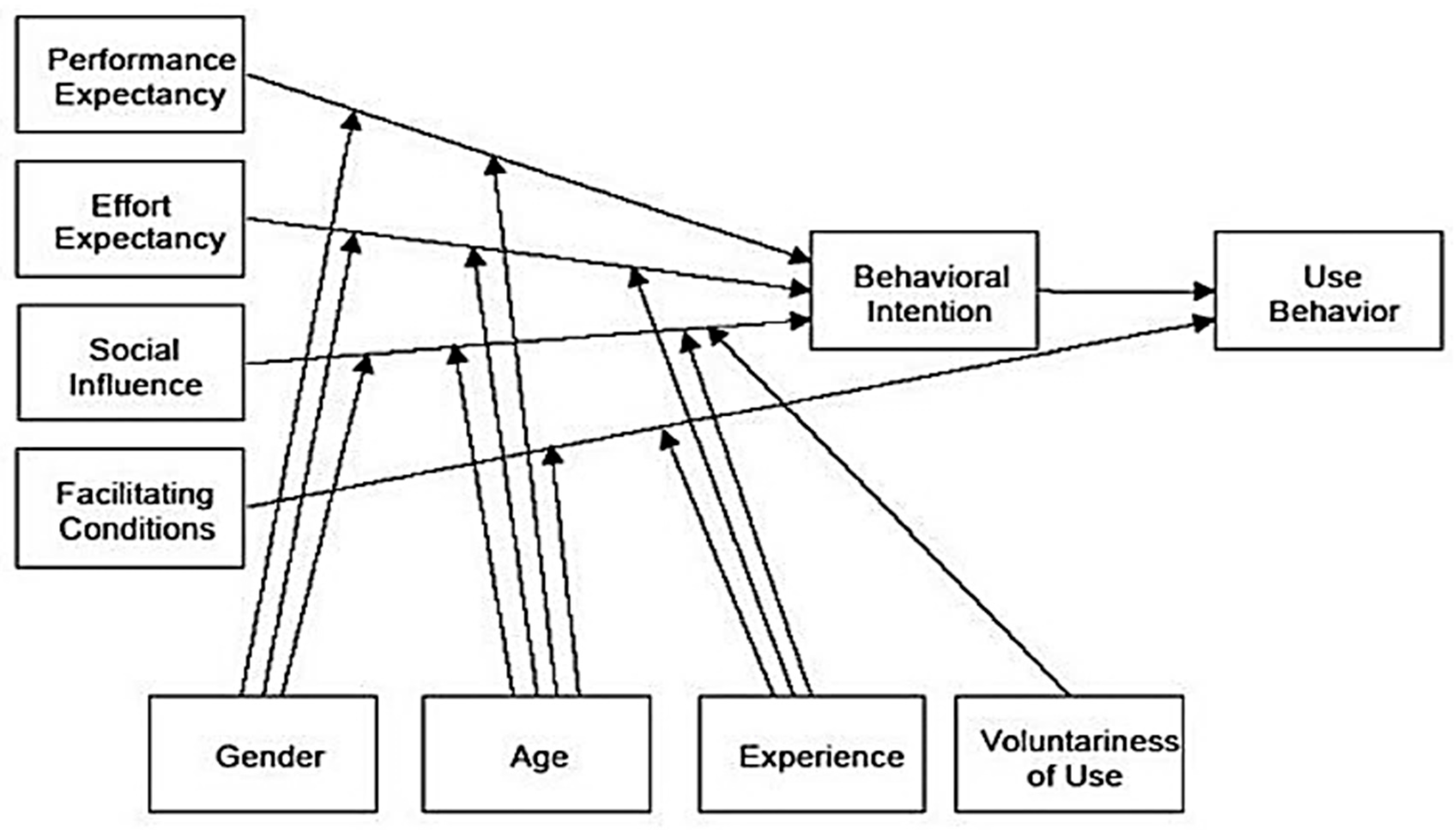
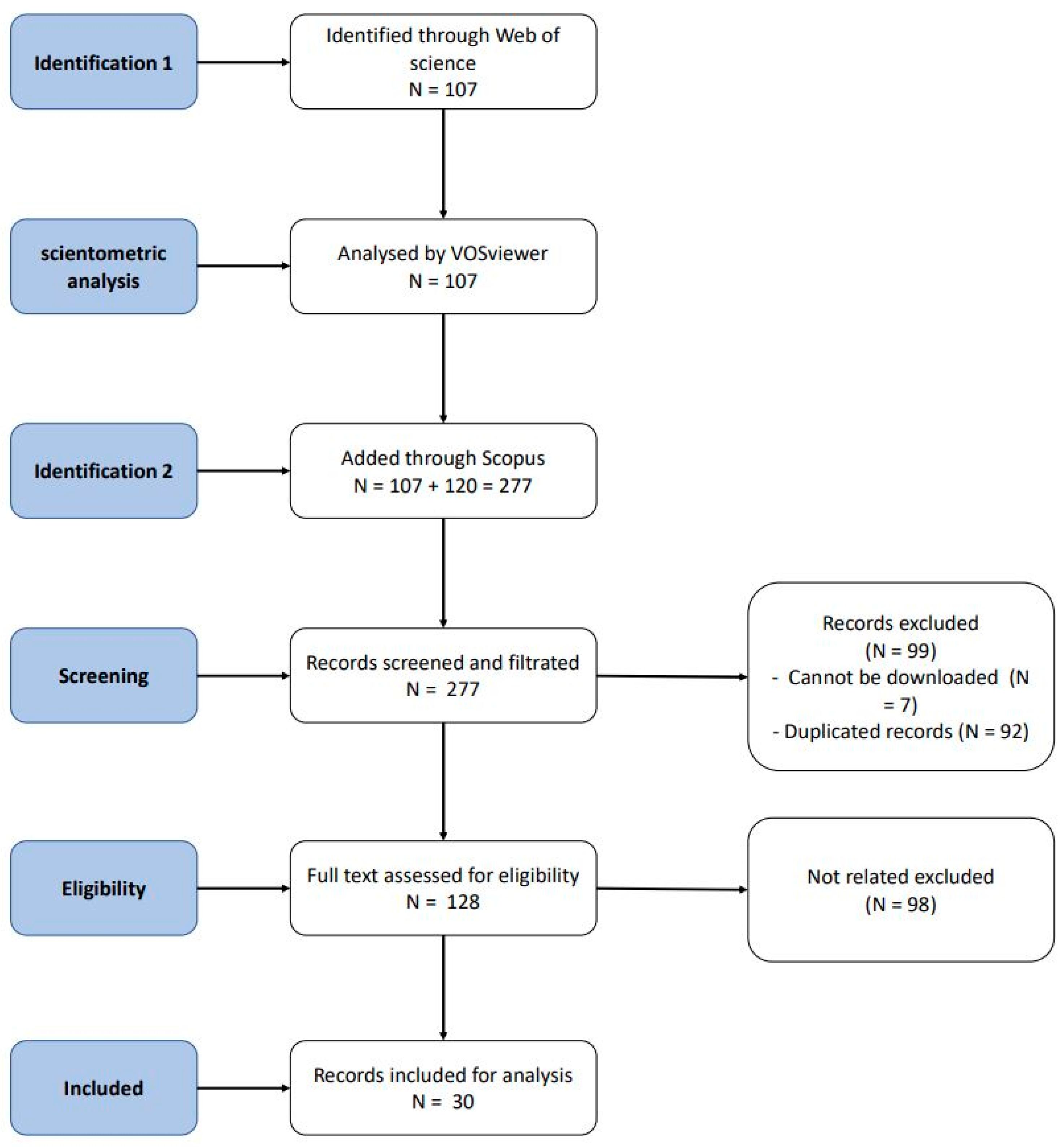
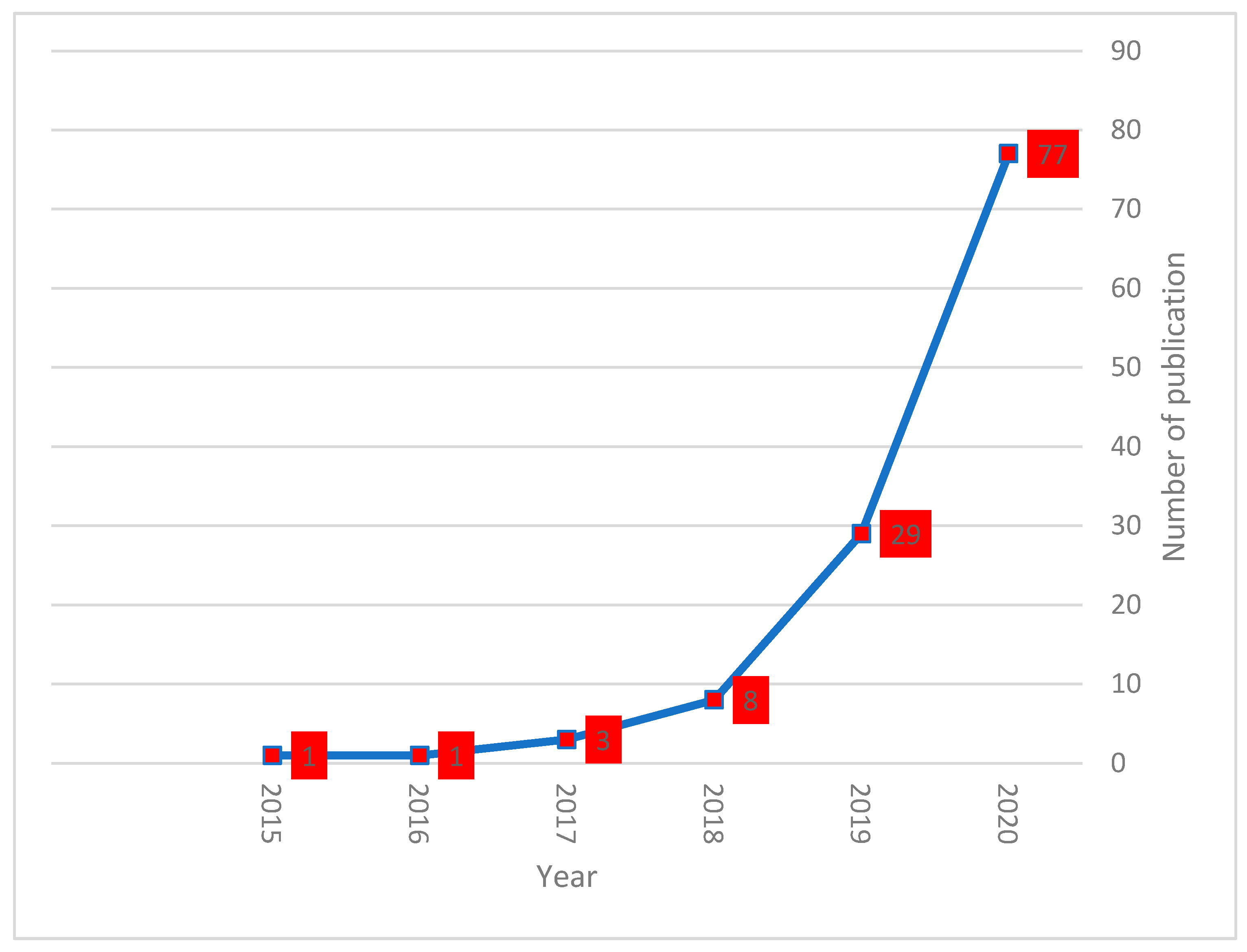

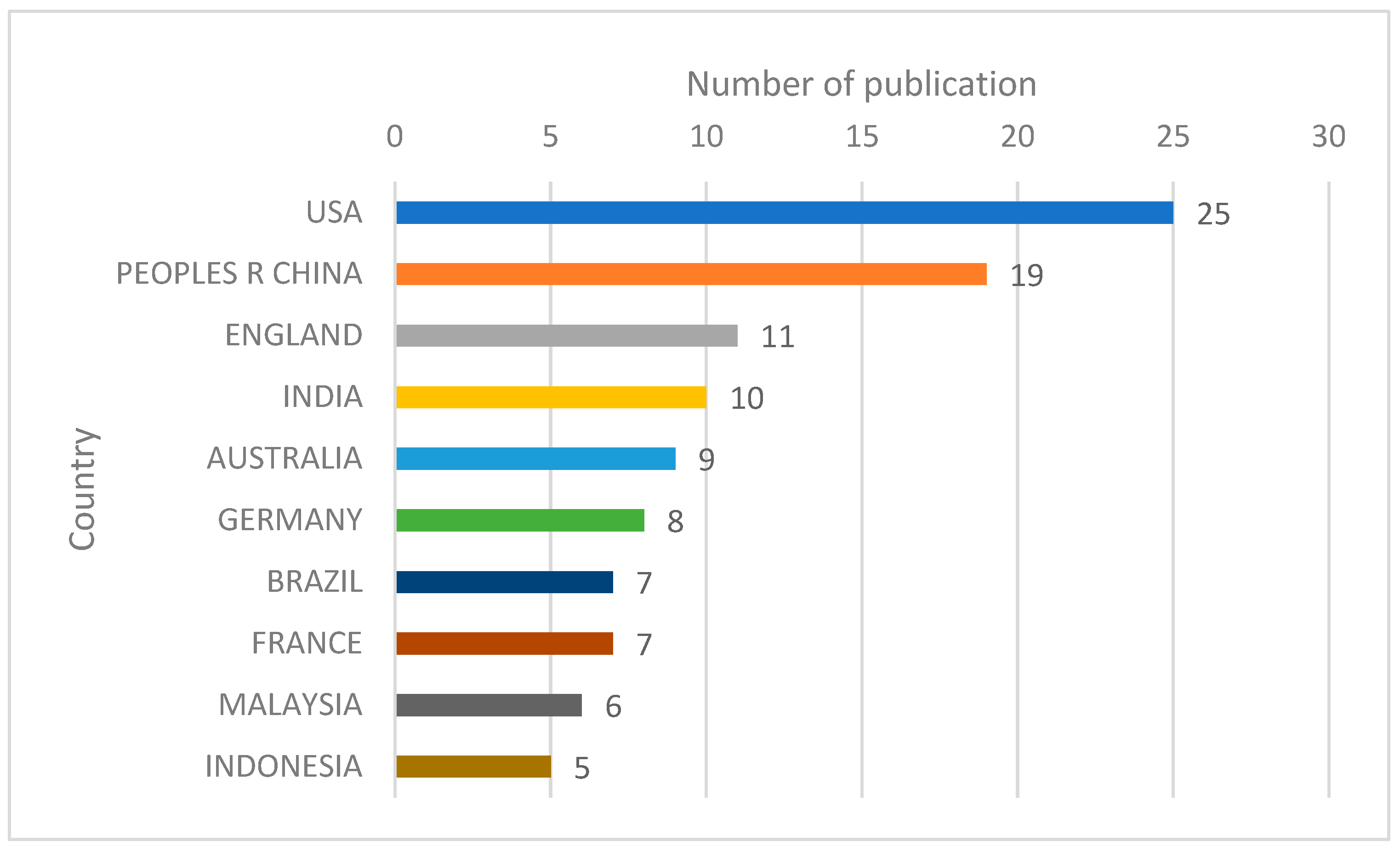
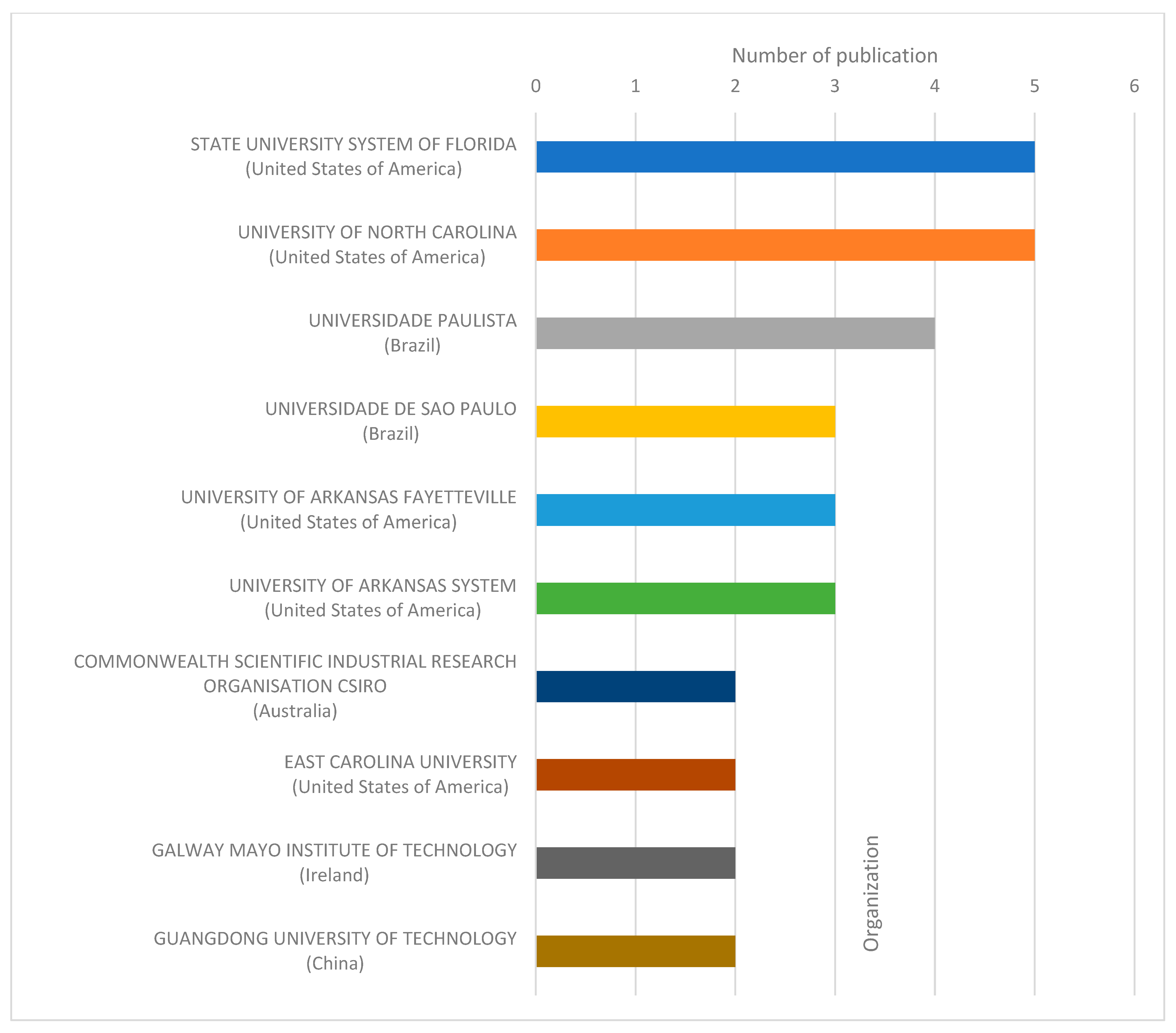


| Keyword | Query String |
|---|---|
| Blockchain adoption | “BLOCKCHAIN ADOPTION” |
| TAM | (“BLOCKCHAIN ADOPTION” OR (TAM)) |
| UTAUT | (“BLOCKCHAIN ADOPTION” OR (TAM OR UTAUT)) |
| DOI | (“BLOCKCHAIN ADOPTION” OR (TAM OR UTAUT OR DOI)) |
| TR | (“BLOCKCHAIN ADOPTION” OR (TAM OR UTAUT OR DOI OR TR)) |
| TBP | (“BLOCKCHAIN ADOPTION” OR (TAM OR UTAUT OR DOI OR TR OR TBP)) |
| TOE | (“BLOCKCHAIN ADOPTION” OR (TAM OR UTAUT OR DOI OR TR OR TBP OR TOE)) |
| TECHNOLOGICAL FACTORS | (“BLOCKCHAIN ADOPTION” OR (TAM OR UTAUT OR DOI OR TR OR TBP OR TOE OR “TECHNOLOGICAL FACTORS”)) |
| ORGANIZATIONAL FACTORS | (“BLOCKCHAIN ADOPTION” OR (TAM OR UTAUT OR DOI OR TR OR TBP OR TOE OR “TECHNOLOGICAL FACTORS” OR “ORGANI?ATIONAL FACTORS”)) |
| ENVIRONMENTAL FACTORS | (“BLOCKCHAIN ADOPTION” OR (TAM OR UTAUT OR DOI OR TR OR TBP OR TOE OR “TECHNOLOGICAL FACTORS” OR “ORGANI?ATIONAL FACTORS” OR “ENVIRONMENTAL FACTORS”)) |
| Blockchain | (“BLOCKCHAIN ADOPTION” OR (BLOCKCHAIN AND (TAM OR UTAUT OR DOI OR TR OR TBP OR TOE OR “TECHNOLOGICAL FACTORS” OR “ORGANI?ATIONAL FACTORS” OR “ENVIRONMENTAL FACTORS”))). |
| Study | Total Citations |
|---|---|
| “The Supply Chain Has No Clothes: Technology Adoption of Blockchain for Supply Chain Transparency” [58] | 180 |
| “Blockchain adoption challenges in the supply chain: An empirical investigation of the main drivers in India and the USA” [59] | 177 |
| “Understanding Blockchain technology for future supply chains: a systematic literature review and research agenda” [60] | 166 |
| “The technology and economic determinants of cryptocurrency exchange rates: The case of Bitcoin” [61] | 139 |
| “Understanding the Blockchain technology adoption in supply chains-Indian context” [62] | 138 |
| “Blockchain and supply chain management integration: a systematic review of the literature” [63] | 87 |
| “Blockchain for and in Logistics: What to Adopt and Where to Start” [64] | 79 |
| “Time to seize the digital evolution: Adoption of Blockchain in operations and supply chain management among Malaysian SMEs” [65] | 69 |
| “Blockchain Applications for Industry 4.0 and Industrial IoT: A Review” [66] | 58 |
| “Blockchain adoption: A value driver perspective” [67] | 54 |
| “Blockchain, adoption, and financial inclusion in India: Research opportunities” [68] | 48 |
| Study | Country | Industry |
|---|---|---|
| [69] | India | Supply Chain |
| [70] | _ | Logistics |
| Supply Chain | ||
| [71] | International | Money Transaction |
| [72] | Spain | Business Based on Bitcoin |
| [73] | Italy | Auditing |
| [74] | _ | Shopping Cart System |
| Data Sharing System | ||
| [75] | Bangladesh | Taxing System |
| [14] | Malaysia | Islamic Banking System |
| [76] | India | Banking System |
| [59] | India | Supply Chain |
| USA | ||
| [77] | Brazil | Supply Chain |
| [78] | India | Logistics |
| [79] | Taiwan | Tourism and Hospitality SMEs |
| [80] | Malaysia | Education System |
| [81] | Australia | Supply Chain |
| [82] | UK | Supply Chain |
| Turkey | ||
| [83] | Vietnam | Multiple Industries |
| [84] | China | Organic Food |
| [85] | Nigeria | Logistics |
| [86] | Malaysia | Intelligence Community |
| [87] | Malaysia | General SMEs |
| [31] | Ireland | General |
| [88] | developing country | Energy |
| [89] | India | Tech Organization |
| [90] | Malaysia | Intelligence Community |
| [91] | UK | Construction |
| [92] | Malaysia | Manufacturing |
| [65] | Malaysia | Supply Chain |
| [62] | India | Supply Chain |
| [93] | Malaysia | Supply Chain |
| Study | Theory | Method | Sample Size | Factor Number |
|---|---|---|---|---|
| [69] | TAM | Online Survey | 289 | 13 |
| TOE | ||||
| [70] | UTAUT | Survey | 172 | 8 |
| TOE | ||||
| [71] | TAM | Online Survey | 251 | 9 |
| [72] | TAM | Online Survey | 248 | 8 |
| [73] | TAM | Online Survey | 279 | 12 |
| UTAUT | ||||
| [74] | TAM | Online Survey | 66 + 53 | 10 |
| [75] | TAM | Direct and Postal Survey | 215 | 5 |
| [14] | UTAUT | Online Survey | 150 | 6 |
| TOE | ||||
| [76] | TOE | Online Survey | 407 | 10 |
| Interview | ||||
| [59] | UTAUT | Survey | 344 + 394 | 7 |
| TAM | ||||
| [77] | UTAUT | Survey | 184 | 6 |
| [78] | TAM | Survey | 240 | 5 |
| Online Survey | ||||
| [79] | TAM | Survey | 101 | 11 |
| [80] | DOI | Online Survey | 198 | 6 |
| TAM | ||||
| [81] | UTAUT | Survey | 104 | 12 |
| TTF | ||||
| [82] | TOE | Interview | 30 | 9 |
| [83] | UTAUT | Survey | 230 | 7 |
| [84] | TPB | Survey | 300 | 6 |
| [85] | TOE | Survey | 15 | 17 |
| [86] | TAM | Survey | 30 | 11 |
| TRI | ||||
| [87] | UTAUT | Survey | 246 | 10 |
| Online Survey | ||||
| [31] | TOE | Interview | 20 | 9 |
| [88] | TAM | Online Survey | 178 | 6 |
| [89] | UTAUT | Interview | 12 | 6 |
| [90] | TRAM | Online Survey | 100 | 7 |
| [91] | TOE | Survey | 104 | 10 |
| [92] | TOE | Online Survey | 103 | 5 |
| [65] | TOE | Survey | 194 | 8 |
| [62] | TAM | Survey | 181 | 8 |
| TRI | ||||
| TPB | ||||
| [93] | UTAUT | Survey | 157 | 8 |
| Factor | Study | Occurrence Times | % |
|---|---|---|---|
| Intention | [14,59,62,65,70,71,72,73,74,75,77,78,79,80,81,83,84,86,87,88,89,90,91,93] | 24 | 80 |
| Perceived Usefulness | [62,69,71,72,74,75,78,79,80,83,86,88,90] | 13 | 43 |
| Perceived Ease of Use | [62,69,71,72,74,75,78,79,80,86,88,90] | 12 | 40 |
| Trust | [59,71,72,74,75,77,81,82,84,85,93] | 11 | 37 |
| Security | [31,62,69,72,74,76,79,85,86,90] | 10 | 33 |
| Performance Expectancy | [14,59,70,73,77,81,83,87,89,93] | 10 | 33 |
| Social Influence | [14,59,70,71,73,77,79,81,83,87] | 10 | 33 |
| Facilitating Conditions | [14,59,70,77,81,83,85,87,89,93] | 10 | 33 |
| Competitive Pressure | [31,65,69,76,82,85,89,91,92] | 9 | 30 |
| Attitude | [62,70,71,72,74,78,84,88] | 8 | 27 |
| Relative Advantage | [31,65,69,76,80,82,91] | 7 | 23 |
| Compatibility | [31,69,80,82,85,91,92] | 7 | 23 |
| Complexity | [31,65,69,79,82,85,91] | 7 | 23 |
| Top Management Support | [31,65,69,82,85,91,92] | 7 | 23 |
| Effort Expectancy | [14,70,73,77,81,87,93] | 7 | 23 |
| Organizational Readiness | [31,69,76,85,91] | 5 | 17 |
| Regulatory Support | [31,65,71,91,93] | 5 | 17 |
| Behavioral Expectation | [59,78,83,87,89] | 5 | 17 |
Publisher’s Note: MDPI stays neutral with regard to jurisdictional claims in published maps and institutional affiliations. |
© 2022 by the authors. Licensee MDPI, Basel, Switzerland. This article is an open access article distributed under the terms and conditions of the Creative Commons Attribution (CC BY) license (https://creativecommons.org/licenses/by/4.0/).
Share and Cite
AL-Ashmori, A.; Basri, S.B.; Dominic, P.D.D.; Capretz, L.F.; Muneer, A.; Balogun, A.O.; Gilal, A.R.; Ali, R.F. Classifications of Sustainable Factors in Blockchain Adoption: A Literature Review and Bibliometric Analysis. Sustainability 2022, 14, 5176. https://doi.org/10.3390/su14095176
AL-Ashmori A, Basri SB, Dominic PDD, Capretz LF, Muneer A, Balogun AO, Gilal AR, Ali RF. Classifications of Sustainable Factors in Blockchain Adoption: A Literature Review and Bibliometric Analysis. Sustainability. 2022; 14(9):5176. https://doi.org/10.3390/su14095176
Chicago/Turabian StyleAL-Ashmori, Ammar, Shuib Bin Basri, P. D. D. Dominic, Luiz Fernando Capretz, Amgad Muneer, Abdullateef Oluwagbemiga Balogun, Abdul Rehman Gilal, and Rao Faizan Ali. 2022. "Classifications of Sustainable Factors in Blockchain Adoption: A Literature Review and Bibliometric Analysis" Sustainability 14, no. 9: 5176. https://doi.org/10.3390/su14095176
APA StyleAL-Ashmori, A., Basri, S. B., Dominic, P. D. D., Capretz, L. F., Muneer, A., Balogun, A. O., Gilal, A. R., & Ali, R. F. (2022). Classifications of Sustainable Factors in Blockchain Adoption: A Literature Review and Bibliometric Analysis. Sustainability, 14(9), 5176. https://doi.org/10.3390/su14095176










